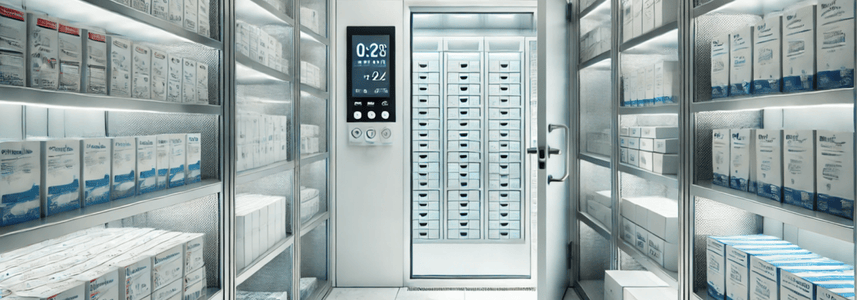How to Choose the Right Cold Room for Storing Medicines

Proper storage of medicines is crucial for maintaining their efficacy and safety. Pharmaceutical businesses must adhere to stringent regulations, such as Good Manufacturing Practices (GxP) and Current Good Manufacturing Practices (cGMP), to ensure drug quality. Selecting the right coldroom is an integral part of this process. This guide will help pharmaceutical companies make informed decisions when choosing a cold room for storing medicines.
Understanding Cold Room Requirements for Medicines
Medicines are highly sensitive to temperature variations, which can compromise their stability and effectiveness. Cold rooms are specialized storage spaces designed to maintain a consistent temperature, typically between 2°C and 8°C, for pharmaceuticals. However, some medicines require freezing temperatures, while others need ambient storage.
Key considerations for pharmaceutical cold storage include:
- Temperature control: Maintaining precise and consistent temperature levels to preserve drug potency.
- Compliance with regulations: Meeting standards set by GxP and cGMP for pharmaceutical storage.
- Capacity: Ensuring adequate space for current and future inventory.
- Security: Preventing unauthorized access to sensitive products.
Step-by-Step Guide to Selecting the Right ColdRoom
1. Identify Storage Needs
Begin by evaluating the specific requirements of your pharmaceutical inventory. Ask these questions:
- What types of medicines need storage? Are they temperature-sensitive?
- Do you require separate compartments for different temperature ranges?
- How much inventory will you store?
Understanding these factors will help determine the size and features your cold room must have.
2. Ensure Regulatory Compliance
Compliance with GxP and cGMP is non-negotiable for pharmaceutical companies. Your coldroom must meet these standards:
- Temperature monitoring: Use calibrated sensors to record temperature data continuously.
- Alarm systems: Install alarms to alert staff of temperature fluctuations or system failures.
- Documentation: Maintain detailed logs of temperature readings and maintenance activities.
Partnering with a reputable cold storage provider experienced in pharmaceutical compliance can simplify this process.
3. Choose the Right Cooling System
Cold rooms rely on cooling systems to maintain stable temperatures. The two main types are:
- Split systems: Suitable for larger cold rooms, offering high cooling efficiency and flexibility.
- Packaged units: Compact and easier to install, ideal for smaller cold rooms.
Consult with a cold room specialist to determine the best option for your facility.
4. Evaluate Insulation and Sealing
Proper insulation is essential for minimizing energy consumption and maintaining consistent temperatures. Look for the following:
- Insulated panels: Use high-quality materials such as polyurethane or polystyrene.
- Sealed doors: Ensure airtight seals to prevent temperature fluctuations.
- Humidity control: Prevent moisture build-up that can damage medicines.
5. Prioritize Energy Efficiency
Energy efficiency reduces operational costs and aligns with sustainability goals. Features to consider include:
- LED lighting: Energy-saving and generates less heat.
- Energy-efficient compressors: Minimize power usage without compromising performance.
- Smart controls: Use automation to optimize cooling cycles and reduce energy waste.
6. Opt for Customization
Every pharmaceutical business has unique needs. Customizing your coldroom ensures it aligns with your operational requirements. Customizable features include:
- Shelving systems: Maximize storage space and organization.
- Temperature zones: Accommodate medicines with varying temperature needs.
- Backup power systems: Prevent disruptions during power outages.
Leveraging Cold Storage for Compliance and Quality
Cold rooms play a critical role in meeting GxP and cGMP requirements. Here’s how they contribute to compliance:
- Consistency: Automated systems maintain stable conditions to meet regulatory standards.
- Traceability: Real-time monitoring and logging ensure accountability and transparency.
- Risk mitigation: Alarm systems and redundancies prevent product loss due to equipment failure.
Key Benefits of Investing in the Right Cold Room
By selecting an appropriate cold room, pharmaceutical companies can:
- Enhance product safety: Protect medicines from degradation caused by temperature fluctuations.
- Boost operational efficiency: Streamline storage and inventory management.
- Ensure compliance: Avoid costly regulatory penalties and product recalls.
- Increase customer trust: Demonstrate commitment to delivering high-quality medicines.
Why Choose Kiat Lay for Your Cold Storage Needs?
Kiat Lay specializes in providing customized cold storage solutions tailored to the pharmaceutical industry. Their expertise includes:
- Designing and installing GxP-compliant cold rooms.
- Offering energy-efficient and reliable cooling systems.
- Providing ongoing maintenance and support to ensure optimal performance.
Visit Kiat Lay’s website to explore their cold storage solutions and ensure your medicines are stored under the best conditions.
Conclusion
Choosing the right coldroom is essential for maintaining the quality and safety of medicines. By assessing your storage needs, ensuring regulatory compliance, and investing in energy-efficient, customizable solutions, you can protect your pharmaceutical products and enhance operational efficiency. Partnering with experts like Kiat Lay can simplify the process and provide peace of mind.
Ensure the success of your pharmaceutical business by making the right choice for cold storage today.


